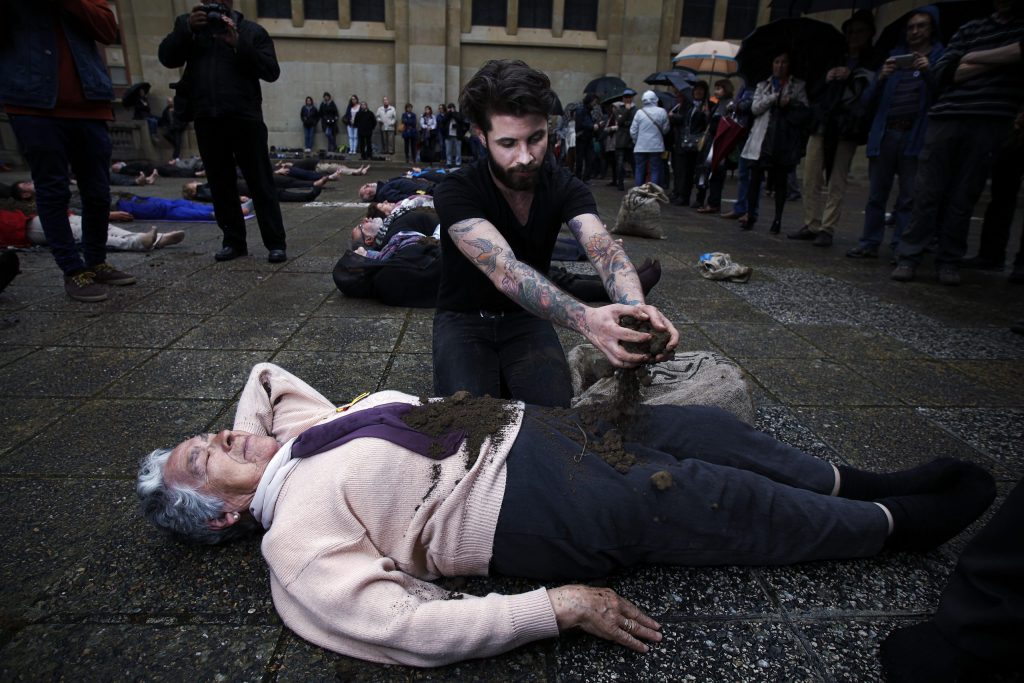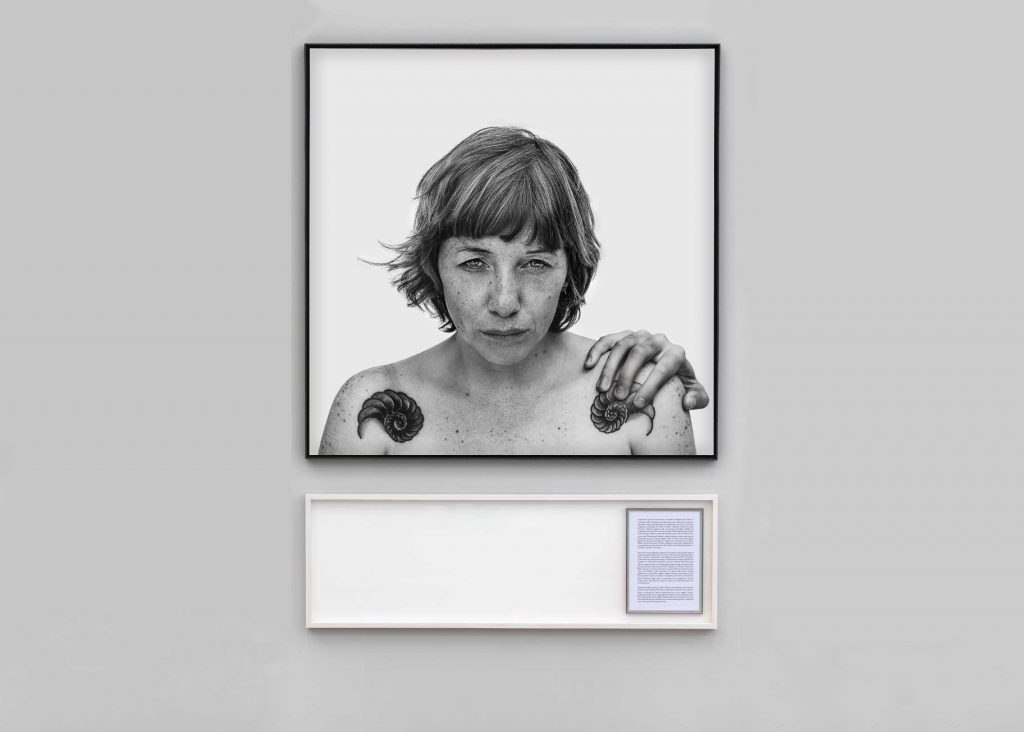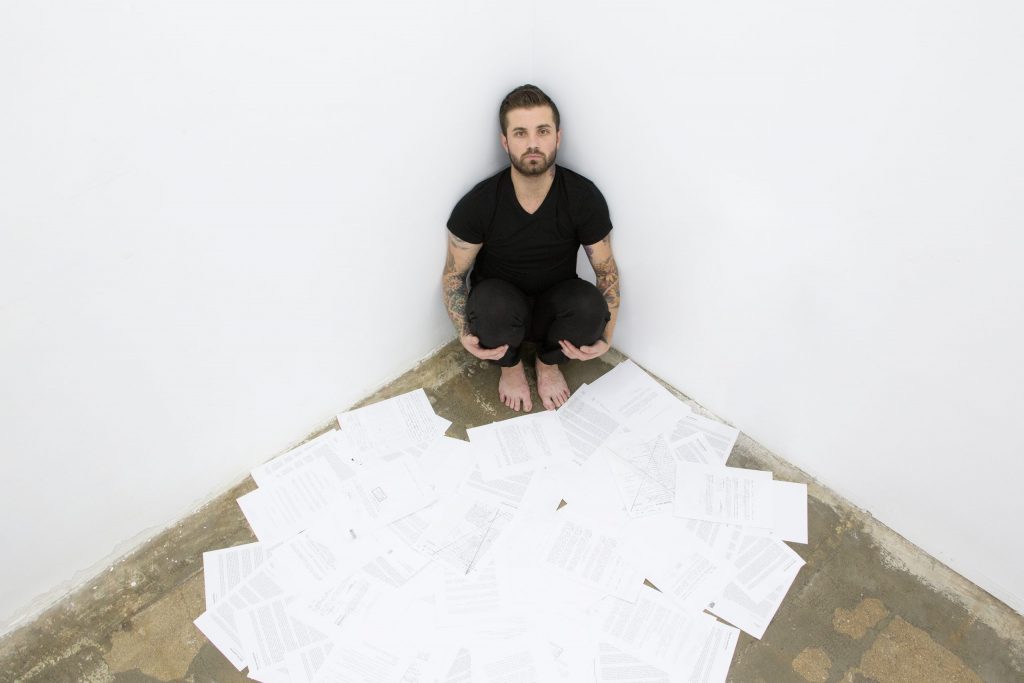Unbound: Abel Azcona

In this period where life hangs in the balance due to the Covid-19 emergency, we have time to reflect on ourselves and think about how to start better than before…when all this is over. Staying at home can be an opportunity to be with yourself and get to know others more. FRONTRUNNER spoke to Spanish artist Abel Azcona (Madrid, 1988) to talk – without inhibitory brakes or moral laws – about his life, his art, and his forthcoming projects. Azcona is a performer and uses the story of his intimate personal life to free himself from chains of the past that have marked him to this day. These include the prostitution of his mother, an unknown father, the violence and the sexual discrimination he suffered, days spent in a psychiatric clinic, and various suicide attempts. In short, Azcona told us about his meaning of [his] life.
Azcona’s performance Empatía y Prostitución | Empathy and Prostitution was chosen as finalist for the 2020 Arte Laguna Prize to be exhibited at the Arsenale (Venice). His work has also been presented at CAC Málaga, the Bogotá Museum of Modern Art (MAMBO), the Houston Art League, the Asian Art Biennale in Dhaka and Taipei, the Lyon Biennale, and the Bangladesh Live Art Biennale. The Bogotá Museum of Contemporary Art mounted a retrospective of Azcona’s work in 2014.

Desenterrados (Buried), 2015-2016
A performance including relatives and grandchildren of those lost during the Spanish Civil War
Sala de Exposiciones de la Plaza de Libertad del Ayuntamiento de Pamplona, Spain
Courtesy of the artist, all rights reserved
When did you feel that art could help you to live together with and, in some cases, solve your internal problems and pains?
I was born an artist because of my mother’s heritage and the context of my own becoming. [The] protagonist and seed of a decade impregnated with heroin and rape. A non-desired conception, gestation and birth. An abandonment. Being brought up in the hands of unstructured families that swung between the streets and prison. My own body mistreated, abused and sold on the streets.
I’ve always tried to compensate devastation with creation. This way, in moments throbbing with fear or pain, I was able to explore gazes and moments closer to catharsis or self-knowledge with my creative inside world. So despite having an…unstructured childhood, I managed to see a silver lining through different artistic disciplines. The few moments of light that I can retrace from the darkness of my childhood come from the subsequent need to imagine, paint, or narrate the acts of utmost violence imaginable in the body of a child. I do not think of art as therapy, nonetheless, it can be understood as a kind of purification. In my case, an intrinsic need.
What was your first work and where was it staged?
My first actions were created out of necessity: I still remember the day I was discharged from a psychiatric clinic where I had been admitted due to various mental issues and a serious suicide attempt. That day, my body interrupted traffic and the walk of the center of my native city, Pamplona – representative of the highest possible forms of Catholicism that had accompanied me over the last ten years of my adoption. From that day on, I’ve used art as a tool that gives me a balance amid catharsis and mental health. That day, sitting on a chair [fully nude], my body depicted an aptitude of empowerment and strength, a beginning of a new existence. It is still interpreted as an outbreak of madness for some and an artistic experience for others. Years later, works with more political and critical content have joined the most personal and reflexive works. If catharsis can be individual, why not be collective? My gaze is not so directed to the personal, but without forgetting my roots and my reality.
Civil rights, abortion, abuse, freedom of expression and religion are a few themes that you demonstrate through your art. Is there one in particular that you care about?
The first works formulate bodily narrations around self-exploration and life experience. Hundreds of them. My childhood marked by my mother, prostitution, abuse and maltreatment; these works rise with a critical and self-explorative spirit. The next works explore topics that affect me directly [in relation to] diversity, abortion, abuse or socio-historical and political level.
I would say that my work has evolved according to the perception of my own reality. Initially blossomed in madness and insanity, my scarce capacities only enabled me to see a short diameter. With time, I obtained assurance and knowledge of myself. My sight has dared to elevate to further aspects and places, opening a wide spectrum of creative courses and acts of disobedience, using art as the first battalion of this revolution. I think of the contemporary artist as a creator of political art, and I think of contemporary art as a transformative tool. All of my work has an easily recognisable critical, social and political content. The artist, if they want to have permission and worth to nominate themselves that way, must let go of all palaver that makes us closer to art as a mere aesthetic element and make themselves a bricklayer for art as a continuous fight. It seeks the sole purpose of understanding and promoting art as a useful tool, and the contemporary artist as a fighter and warrior.

Visibles (twenty life experiences of prostitution survivors)
March 2015, Bogotá, Colombia
Courtesy of the artist
In Las Horas (2015) which you performed at the Rossmut Gallery in Rome, you allow visitors to spend time with you by paying 100 euros. How do you feel when you stage your own life every time, such as that of your mother when she prostituted herself?
One of the most well-known lines of my work is the scope of linking art and prostitution. From the art and market point of view, it possesses some jocularity [related to] a son of the prostitution system. I have been prostituted as a son, an heir, emulating my mother’s figure, as an artist and as a creator. In my particular case, empathy with prostitution goes further.
It’s been eight years since that cold afternoon already, when in the main public art gallery of Bogotá hundreds of people waited at the doors to come in and abuse my naked body. The inside of the installation recreated a bed of intimacy. Visitors could access my body freely, always from a critical spirit, and with the idea to reproduce the pattern of what happened the night of my conception. That night could be described in many ways. One of the multiple readings is the paying [for] and abuse [of] a grown man – for me, representing a part of the Spanish society is like. Another of a woman (my mother) representing another side of Spanish society, as if it were a repetition of the Spanish Civil War. In summary, a woman, heir of a system, abused by a man, representation of a Catholic and apostolic patriarchy. An exchange between a prostitute, my mother, and a prostitution client, my father. This work accompanied my pain in cities with clear [conflict] heritages such as Madrid, Houston, Bogotá, Paris, and Tirana.
Reactivating works such as this one, we see sexual intercourse, anal penetration, fellatio and acts of this nature live in cities as Houston and Tirana. In the moment of producing the act, sodomy and civil rights were considered some things that should be persecuted. In this journey, I found a space in Madrid where sexual exchanges had happened for years, and I decided to activate this same project, evolved, named The Hours. 24 participants, out of 100 candidates, were picked at random for reproduction of the initial piece. This time, we included more detail linked to a real prostitution relationship with the purpose to intervene, curatorially, in the purport of the work. An hour of intimacy was filled with requests and moments with a clear sexual connotation generated photographic documentation, letters from the participants, and other media with which we created the homonymous expositive installation in the gallery. We decided to reactivate a live performance for the opening day. For days, we abandoned the beauty of Rome to drive and walk the outskirts to find my mother. My biological mother, missing in that moment, had to appear in the suburbs of Rome in a metaphorical way – in the figure of another woman. Days later, we found Georgia who inaugurated the exhibition next to my half naked body, creating a repetition as if it was a last hour. Photographic and narrative processes from The Hours were joint by a bodily performance.
These processes are complicated, but the spectator or viewer leaves the gallery transformed and it involves a learning and cathartic experience for me. The art gallery implodes, the visitor is moved and abandons the place. The pain is dormant, catharsis may be too, and the doubt of if that reliving builds me or destroys me. I feel as if I’m writing days over already written verses.

If you could go back in time, would you change anything? Would you make other choices?
I do think about it daily, because I think that one of the virtues of performance is having the possibility to make a regression as it’s being carried out. I’ve always advocated for, and [still] advocate for, abortion as one of the best measurements for child protection. I have always defended my right to not be born. Being born for the sake of being born and other shit Catholic heritages. My biological mother, prostituting herself and consuming heroin, tried to abort me on three different occasions (Thank you, mom.) Hence, my affirmation about this being the greatest act of love anyone will ever do for me. Not having been allowed to abort me, I went from a gestation marked by consumption and bad habits to a childhood where the same things continued, garnished with a little bit of neglect, rape, child prostitution, and a little bit of helplessness. So if I could go back, I would sew my mothers vagina from the inside and I would never be born. Now, already born, and having given birth to as a political object, I use my life, feeling and body as a political weapon.
I consider you the male version of Marina Abramović, who uses her body to tell and speak about herself. It would be nice to see a collaboration: generations and epochs in comparison. What do you think?
One of my biggest defences in performance art is the discourse, so I consider that each artist empower their life experiences as they understand them, are able to and want to. Abramović’s work opened doors at the time, however I consider that the discourse and politics are more important than the artist’s presence. A big difference between our [practices] is that Abramović’s work was a disruptive act with the generalized idea of what art is or is not considered to be and women’s part in it during the 60s and 70s. In my case, the disruption persists as a heritage of the new established system. We have met a couple of times and, despite our very different visions, we both understand the body as a political weapon and life experience as a narrative work. If, someday, a museum or gallery invites us to performatively dialogue, it may happen. If not, one way or another, each one at our own time and with our own lives, we’ve already talked through time.
I read that your last performance will be to commit suicide. What do you want to demonstrate with this gesture? Or is it a form of marketing?
As I have said before, I defend the right to not be born, even as a measure of child protection. In that obligation, to be born is implicit, hence the reason why I am giving myself the right to decide how and when to die. Some years ago I proposed this project, which in a short period of time will put an end to my life, both physically and conceptually. This project as closure will also give every work in which I explore life, death, and other experiences a curatorial meaning. Thus, the discourse will remain and prevail over the artist.

Expedient 09812 (2019)
A work based on the origins of the artist
Museo San Telmo / Galería Kur, Donostia-San Sebastián, Spain
Courtesy of the artist
In Make America Great Again, you oppose Donald Trump’s policies. The title of the performance recalls the slogan of Ronald Reagan’s 1980 presidential election, which Trump himself used for his [own] campaign in 2016. Use this space to send a message to the President, now.
I have been an immigrant in each one of my journeys to the United States for years; trips of months or even years. So in 2013 I decided to carry out a series of actions with an ironical point of view about my own vision of American culture. To speak about the cultural event and how performative it is that a subject of such low human quality holds the presidency makes us understand American culture and ideals, something close to Neo-Dadaist. These actions, all of them, are ironic and jocular. In a museum, I ate 50 hamburgers from a renounced American brand, or I got tattooed with the supremacist slogan of Trump’s last campaign. All of these actions have a critical intention and the aim to graze [at] the grotesque, which in my opinion describes where the United States is at this point in time.
What do the words “absence” and “pain” mean to you?
An artist, who lives in Paris, called Esther Ferrer talks about performance as “space, time and body”. I think it is one of the most accurate definitions made of an art still misunderstood. In my case, these three terms can be replaced by the word “absence” that you mention, so that the construction, or destruction in my situation, results much more complicated. Not having much attachment to life is due to not having great attachment to anyone, in particular. I do not have a mother, nor a father, nor do I have a family. Because of this, I can create, I can denounce to the extreme. I have not become radical, I was born radical. Regarding pain, if you put my first hundred pieces in front of my eyes, I would see the self-harming and pain exploration factors in them. With time, I’ve learned to live with wounds, and through art I have been able to formulate and reformulate, open and reopen may of them. I have been born to be sad, I have been born to suffer.

You are a finalist in the Arte Laguna 2020 Prize with the performance Empatia y Prostitución. With this project you will close an artistic cycle at the Venice Biennale. Why?
For a decade I have done projects with explicit sexuality such as this piece and others in which, as a metaphor of my own conception, first abuse and self-harming moments in the sexual that come from my own mental illness. The spectator could abuse and rape my body. I accomplished a critical and political experience around abuse, my father’s experience and my own. These works have helped me leave a sediment and an ideology about prostitution and my own life. The viewer becomes my father, practicing violence in me. The discourse is already clear and, on my end, catharsis explored to its limit, so right now I’m working on pieces that possess another vision.
It is a privilege to close a work so intrinsically linked to myself inside the Venetian Arsenale, one of the epitomes of contemporary art, on top of the meaning it has to me due to my personal connection to Italy for sex-themed projects previously done. So, Empathy and Prostitution being awarded and shown in the Arsenale is important to announce the political and critical discourse of this piece.
What will your next cycle be? What will your next projects be?
I still have years ahead of me full of politically empowering projects. In this new cycle, I welcome projects with a more political and global meaning where the presence of the artist is not that relevant. A few months back, I was denounced by the Israeli government for installing two meters of the Berlin Wall segments along the West Bank Wall, conceptually fusing the two historical events. Death threats, judicial processes, aggressions and denouncements as the response of a totalitarian system.
In the difficult moment that we find ourselves in, with the rise of the extreme right, contemporary art must be a useful tool of transformation and awareness. My next invitations national an international exhibitions – and important Latin American and European biennales – will be protagonized by using art as a process tool that detonates a social and political change in the context of the creation itself.
It is time to die creating.